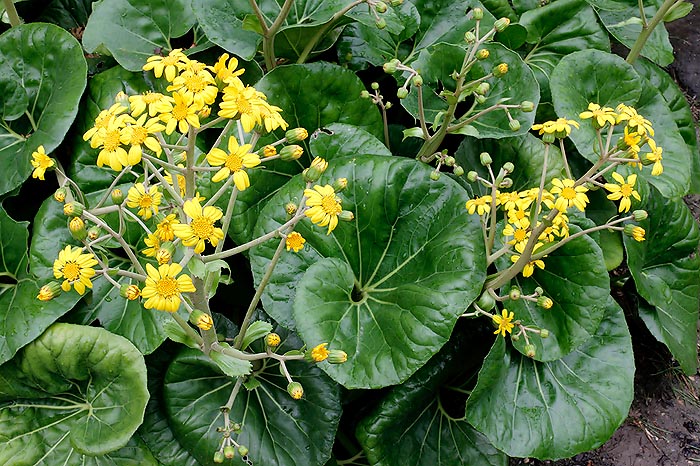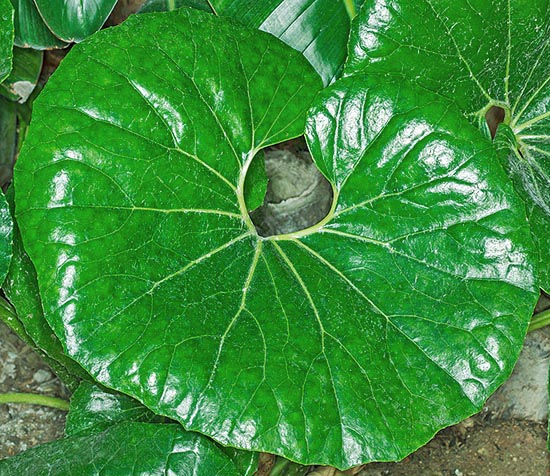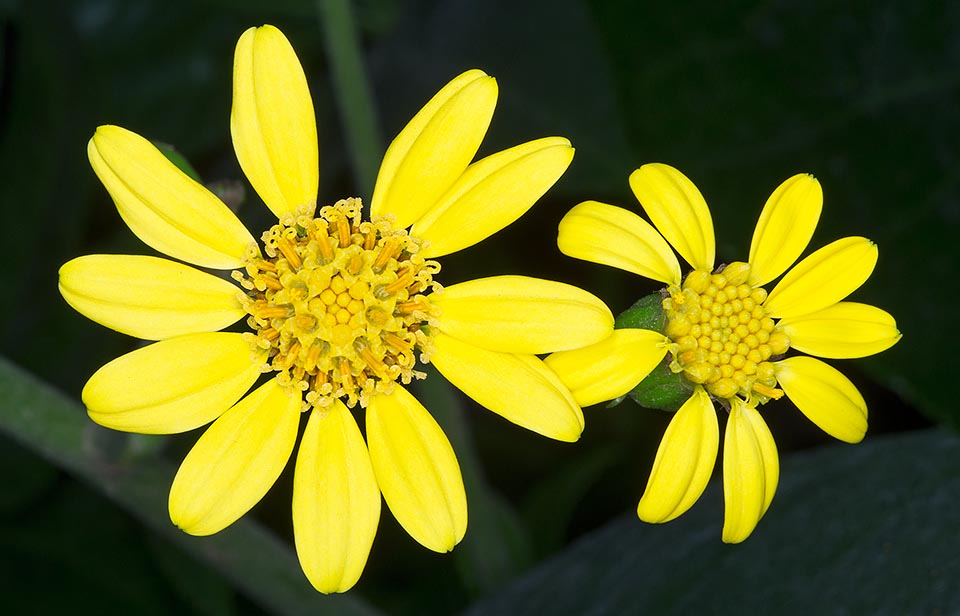Family : Asteraceae

Text © Pietro Puccio

English translation by Mario Beltramini

Cultivated mainly for its great unusual leaves. Shade loving, saltiness resistant, back into style © Giuseppe Mazza
The name of the genus comes from the Latin “far” = spelt, flour and “fugio” = to run away, to disappear, with reference to the white pruinosity on the petiole and the floral stem which disappears precociously.
The name of the species “japonicum” = of Japan, refers to one of its origin countries.
Common names: leopard plant (English); pata-de-cavalo, planta-leopardo-gigante (Portuguese); boina de vasco, capa de la reina, gorra de vasco (Spanish); Leopardenpflanze (German).
The Farfugium japonicum (L.) Kitam. (1939), is an evergreen, herbaceous and cespitose plant, acaulous, rhizomatous, 30-45 cm tall and about 60 cm broad; with big and showy leaves on an erect petiole, 10-35 cm long, initially covered by a slight white tomentum which then becomes glabrous. The leaves, of 20-30 cm of diameter, are coriaceous, circular, heart or kidney-shaped, of a glossy dark green colour and curved, smooth or indented, margins and clear nervations departing from the centre of the leaf.

Even 30 cm broad, the leaves recall the Belle Époque bombastic inclinations © Giuseppe Mazza
The fruits, containing one seed only and called achenes (or, more properly, cypselae) in the Asteraceae, are cylindrical, 0,6 cm long and surmounted by the pappus, the modified calyx of the flower, formed by a crown of about 1 cm long bristles, which has the function to help their dispersion. It reproduces in spring by seed, or, very easily, by division.
Plant mostly cultivated for its great glossy leaves and, in the numerous varieties, for the white and yellow streaks and mottles, of which the most famous is the ‘Aureomaculata’, which earned it the name of “leopard plant”. It very well adapts to filtered or dimmed light situations, as it does not stand the direct sun, except for a few hours, it may be therefore advantageously utilized as ground cover or as edge under the trees; it has a quite good resistance to the marine aerosols, and therefore it can be employed in areas close to the sea side. It prefers humid, light and draining, soils, provided enriched by organic substance; it resists well to the low temperatures, the leaves may resist up to about -6 °C, the plant to -16 °C, or even to -20 °C, with a good mulching. It also adapts to the cultivation in pot, with the same aforementioned modalities.

The capitula are modest indeed but create a cheery touch of colour in midwinter © Giuseppe Mazza
Synonyms: Tussilago japonica L. (1767); Arnica tussilaginea Burm.f. (1768); Senecio japonicus Less. (1832); Senecio kaempferi (Siebold & Zucc.) DC. (1837); Farfugium kaempferi (Siebold & Zucc.) Benth. (1839); Farfugium grande Lindl. (1857); Senecio tussilagineus (Burm. f.) Kuntze (1891); Ligularia tussilaginea (Burm. f.) Makino (1904); Ligularia tussilaginea var. formosana Hayata (1919); Ligularia nokozanensis Yamam. (1928); Farfugium tussilagineum (Burm. f.) Kitam. (1939); Ligularia kaempferi Siebold & Zucc. (1939); Farfugium japonicum var. formosanum (Hayata) Kitam. (1942).
→ To appreciate the biodiversity within the ASTERACEAE family please click here.
